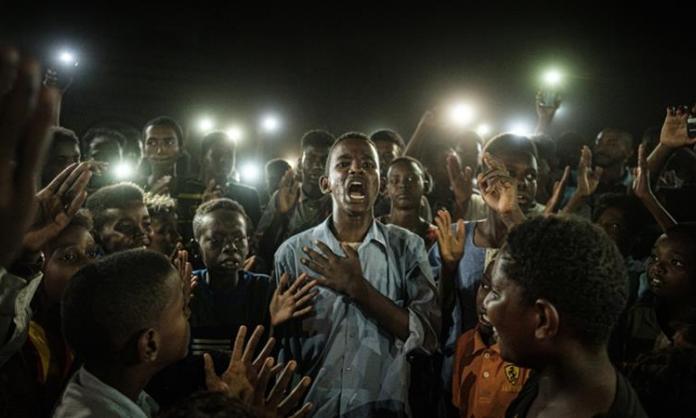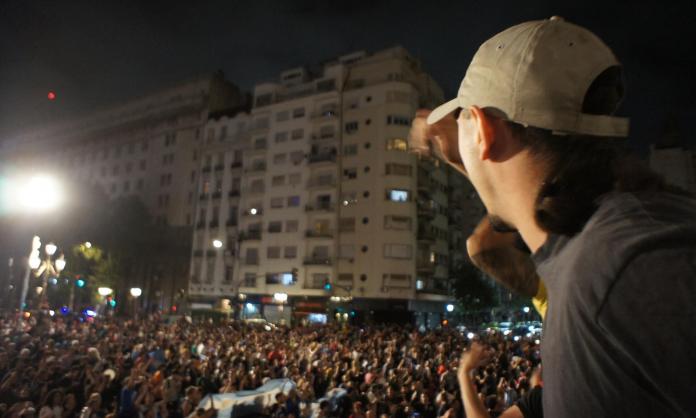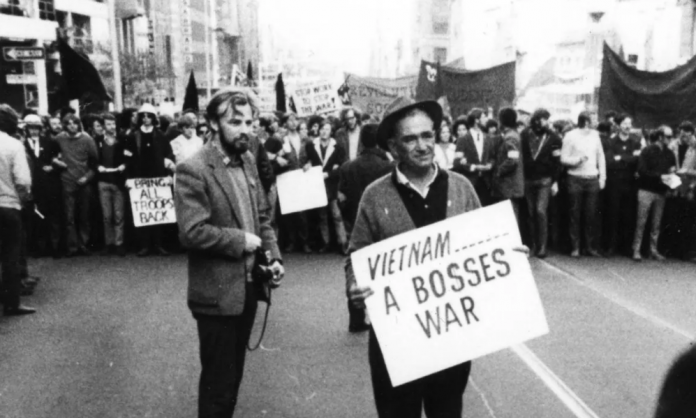What are the prospects for revolutionary politics in the era of COVID-19? Amid the destruction, both human and economic, some have struck an optimistic note. Ben Tarnoff, for instance, in an article published in US magazine Commune, writes: “In retrospect, 2020 may end up being a 1968 or a 1917: a year of leaps and ruptures, and a dividing line between one era and the next”.
Many also thought that the global financial crisis of 2008-09 would be the death knell of neoliberalism. But instead of breaking with the economic orthodoxy that had triggered the crisis, governments shovelled trillions of dollars of public money into the coffers of big banks and corporations. Workers around the world paid a heavy price – savage austerity, further privatisations and relentless attacks on unions – for the ruling class’s determination to prop up its tottering economic model for a few more years.
But while neoliberalism was retained as the dominant economic model for capitalism, politically, it was dead in the water. Millions of people around the world came to see “centrist” politics for what it really is – a cover for the organised looting of society by a capitalist class drunk on greed. Financial markets boomed, but global elites and their political servants were battered by insurgent populist challenges on both the left and the right.
The COVID-19 crisis is a greater order of magnitude than the last financial crisis. Given the political bankruptcy of neoliberalism, it’s hard to see how it could ever be fully revived. The system can’t be saved this time via bailouts of the banks and major corporations. In their desperate efforts to save capitalism from total collapse, political leaders across the major world powers have launched aggressive government-led interventions into the economy and society.
This situation opens new horizons for the revolutionary left. One of the most stifling aspects of the neoliberal era has been its success in inculcating the sense, among wide layers of workers and the poor, that there is no alternative to capitalism. The idea that individual competition and the free market are the natural order of things is drummed into us from an early age. And the reality of capitalism we confront as we grow up only reinforces this.
The developments of the past month have shaken these assumptions to their core. Who would have thought, two months ago, that the thoroughly neoliberal and right-wing Coalition government in Australia would pour hundreds of billions of dollars into a doubling of dole payments, wage-subsidies and free childcare?
For decades, we’ve been told there’s simply not enough money for such things. Not enough for decent welfare, health care and education, and certainly not enough for anything “visionary” like avoiding catastrophic, runaway climate change. One thing that hopefully will come from this is people never again believing politicians when they say that “there’s not enough money”.
In our social isolation, we may dream of revolution. But what are the prospects of turning such dreams into reality? For this we need more than just imagination, we need struggle. And we need the kind of struggle that has been lacking in the neoliberal era – workers’ struggle. Amid the desolate landscape of mass unemployment and suffering caused by the pandemic and associated economic collapse, there are some small glimmers of hope in this regard. As Tarnoff writes:
“The pandemic spins up a cycle of proletarian self-activity. Workers everywhere now have an urgent issue to agitate around – their health – and are already organizing on that basis. Wildcat strikes have broken out among garbage workers, auto workers, poultry workers, warehouse workers, and bus drivers. Amazon has seen a wave of militancy, forcing management to promise better health protections and to extend paid time off to its entire workforce … Unionized nurses have rallied to protest shortages. Workers at GE have demanded repurposing jet engine factories to make ventilators.”
Similar struggles have broken out among key sections of workers in other hard-hit countries such as Italy, Spain and France. Even in Australia, there have been a number of small scale actions by workers over health and safety concerns, and signs of resistance among unionists in some sectors (notably higher education) to attempts by bosses to use the crisis as cover to attack wages and conditions. These are encouraging signs. For revolutionaries, however, it’s important to remember Gramsci’s maxim: pessimism of the intellect, optimism of the will.
We have reason to be hopeful that the current crisis will be a turning point in the fortunes of revolutionary politics around the world. Even before the COVID-19 crisis broke, we’d seen a string of revolts shaking the establishment from Sudan to Chile, France to Iraq. The crisis will no doubt intensify the contradictions that drove these revolts. We should, nevertheless, harbour no illusions about the scale of the challenge we face.
In this period of profound destabilisation, we’re witnessing an almost complete consensus within official politics and the mainstream of civil society. In Australia, prime minister Scott Morrison is now governing at the head of a tacit political alliance incorporating not only the opposition Labor Party, but also the trade unions, big business organisations and all but the most right-wing fringe of the corporate media.
In country after country, the situation is the same. The usual noisy show of political fractiousness has been put on hold. Political and institutional authorities speak with one voice: in this time of crisis we should put our differences aside and work things out cooperatively for the common good.
This is a charade. The illusion of “national unity” is created not by any genuine convergence of interest between the working class and the capitalist ruling class, but because so many of the organisations and institutions that in ordinary times pose as critical voices within the political sphere now stand openly on the side of the capitalist state and the corporate elite it serves. The state remains, as Marx put it, “a committee for managing the common affairs of the whole bourgeoisie”. But with the voluntary silence of formerly critical voices, it appears a neutral body managing society in the interests of all.
These developments highlight something that was theorised, in different ways, by Antonio Gramsci and Leon Trotsky in the tumultuous, crisis-ridden period between the two world wars. Both pointed to the way in which, in Western democracies, the rule of the capitalist state is maintained not only by the brute force of the police, the army and so on, but by the institutional authority of major civil society organisations (including unions) and reformist political parties.
The state in developed Western democracies was, for Gramsci, the “integral state” – a state that in ordinary times appears to stand suspended above society, but which in a time of crisis is revealed to be something that has, through the network of established political and civil society organisations, very deep roots. As Gramsci put it: “In the East [Russia], the state was everything, civil society was primordial and gelatinous; in the West, there was a proper relationship between state and civil society, and when the state trembled a sturdy structure of civil society was at once revealed”.
Trotsky at times wrote in similar terms, particularly about the trade unions. Reflecting on their role both in fascist countries such as Germany and Italy, and in democracies such as France, in 1938 he noted an increasing integration with the state. “The cause of this tendency towards state co-optation”, he wrote, “is that capitalism in its decline cannot tolerate independent unions”. More and more, he argued, “the unions are directly integrated with the state, with capitalist proprietors. It’s only a difference of degree, not of nature”.
Those wishing to see the further development of the initial, inspiring flashes of workers’ resistance around the world will have to contend with this reality. The barriers to the widening of such resistance are formidable – in particular the entrenched union bureaucracies and reformist political parties whose every instinct in a crisis is to use their authority with workers to buttress the state and quash any serious outbreaks of unrest.
That’s not to say that revolution is ruled out once and for all. In periods of deep crisis, politics can develop at breakneck speed. The revolutionary upsurges that swept from Russia into Europe in the aftermath of World War One provides a clear example. The longer the crisis drags on, the more the spirit of national unity and cooperation will start to fray, and the national unity block will be revealed more and more as the dictatorship of capital that it is.
However, revolutionary socialists remain a tiny minority in Australia and in most other countries in the world. Tarnoff, perhaps unintentionally, highlights the isolation of the revolutionary left in the US when, at the conclusion of his article, he calls for a socialist project that is “equal to the radicalism of our reality”. This project, he writes, “must offer a socialism that is not a branch of progressivism or a wing of the Democratic Party but a truly anti-systemic alternative, one that promises, however improbably, an end to the death cult of capital and the elevation of human health, dignity, and self-determination as the supreme organizing principles of our common life”.
This is, indeed, what we so desperately need. But in the US, for the past two years at least, the tide has been flowing in the opposite direction. Many former revolutionaries have been drawn behind Bernie Sanders into the “democratic socialist” wing of the Democratic Party and have focused almost entirely on electoral politics rather than anything “equal to the radicalism of our reality”. The concurrence of the COVID-19 pandemic and the end of Sanders’ run for president may well provide an opening to push back on the reformist current. That, however, will require much more than just revolutionary hopes and dreams.
There is no substitute for the hard work of revolutionary organising and education, and of the day to day participation in the struggles of workers and the oppressed, wherever and whenever they may arise. Given the scale of the crisis and the quickening pace of political developments, however, this is unlikely to be a straightforward continuation of the practices of the preceding decades. Globally, new fronts of resistance are opening up almost daily. Even in Australia, the pace of events, relative to “normal” times, is dizzying. We’ll need, no doubt, all our reserves of energy, optimism and will, just to keep up.
We are small. But we stand on the right side of history. As Indian writer and activist Arundhati Roy famously put it, “Another world is not only possible, she is on her way. On a quiet day, I can hear her breathing”.











